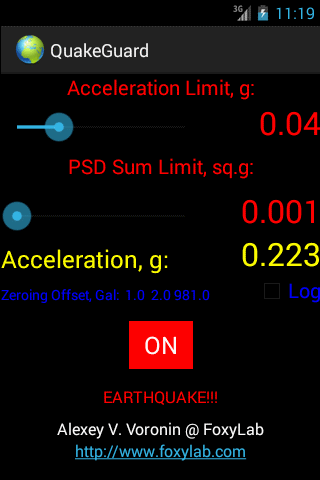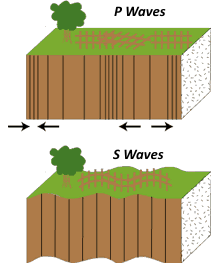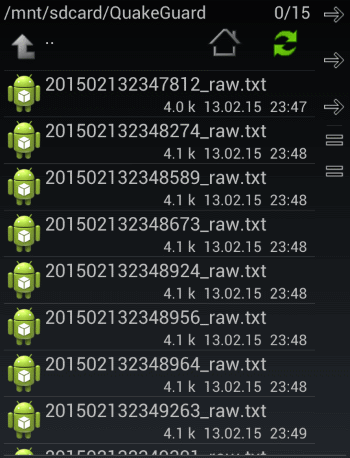QuakeGuard 1.1
|
Feedbacks
Read more > Leave your feedback!
Leave your feedback!Do you want to win precious seconds and minutes in an earthquake?
Then QuakeGuard - that is what you are looking for!
The application "QuakeGuard" is designed to warn of seismic activity by detecting the "P"-earthquake waves (mainly vertical) with the accelerometer before the destructive "S"-wave (mainly horizontal) to reach your area.
System Requirements
Android 2.2 or higher.You are using application "as is", at your own risk.
QuakeGuard is distributed under CC BY-ND 3.0 license ("Attribution-NoDerivs").
Downloads
 |
Application is distributed in the form of APK-file. |
Checksum APK-archive MD5: d40a633d27ceabb1f8c59481784f9d28 - 1.1

|
|
QuakeGuard 1.1 (APK-file) - 307 KB (released August 06, 2013) - Download From https://foxylab.com |
Earthquake warning
One of the most common natural phenomena that bring human and economic losses are earthquakes. The main danger of earthquakes lies in their surprise. The large loss of life is usually due to the lack of any product prior notification of when an earthquake.
Earthquakes produces two main types of waves: P(pressure)-waves and S(shear)-waves.

P-waves are like sound waves - matter in one place pushes against adjacent matter compressing it. The result is a series of alternating stretched and compressed rock propagating in the same direction as the compression. P-waves can travel through solid and liquid material and move faster than S-waves. P-waves are the least destructive of all seismic waves.
S-waves are like waves in a jerked rope - matter moves up and down or side to side. Liquid matter prevents S-waves from spreading.
Damage to the railways S-wave -

This application is designed to warn of seismic activity by detecting the P-waves (mainly vertical) with the accelerometer before the destructive S-wave (mainly horizontal) to reach your area.
This is possible due to different rates of spread of P- and S-waves -

If the distance from the epicenter of 200 km, the difference between the arrival at P- and S-waves is about 30 seconds which can be invaluable!
In a disaster situation, every second counts toward saving lives.
An example of such a system is a early warning system for George Massey Tunnel in Canada -

QuakeGuard features
To monitor the seismic situation your device must be placed on a horizontal stationary surface and run the application. When you first run the application accelerometer of your device will be calibrated. Calibration can also be run from the pop-up menu that appears when you press the "Menu" smartphone.
After completion of the calibration, by pressing the "OFF" button to transfer the application to control the vertical acceleration of the surface ("ON"), which is located on your device.
A running application prevents your device from going to sleep.
The level of sensitivity to vibration can be easily set using two parameters:
* Acceleration Limit (peak acceleration), in units of gravitational acceleration g (the recommended value of 0.04);
* PSD Sum Limit, in units of sq. g (the recommended value of 0.001).
When exceeding the predetermined acceleration limit data (vertical acceleration) collection begins (128 samples at an interval of 20 milliseconds) for 2.56 seconds. Then, the spectral analysis (FFT) of the data is performed and determines the PSD Sum Limit in the frequency range 0.5 - 15 Hz, typical for "P"-waves.
If the PSD Sum Limit are exceeded, a loud siren sound will wake you up.
Siren off automatically after one minute after the earthquake (or force it can be turned off by pressing the "ON", this disables the control regime).
Using spectral analysis eliminates false alarms!
Possible logging suspicious seismic activity (text log files are stored in / QuakeGuard on your device) -

Log file example:
-
f = 50
n = 128
a max= 1.013
a min= -0.717
0 ms 0.15
20 ms 0.021
40 ms 0.002
...
2480 ms -0.029
2500 ms -0.065
2520 ms -0.162
2540 ms 0.225
df= 0.390625
Lo f= 0.5
Hi f= 15.0
0,00 Hz 0.1159375
0,39 Hz 0.16394696575222073
0,78 Hz 0.13416826695317635
1,17 Hz 0.10219072490033809
...
24,22 Hz 0.003418050937392119
24,61 Hz 0.01272966236892362
25,00 Hz 0.013906250000000009
SS= 0.09627567126394772
Whats new in QuakeGuard 1.1
* first public versionRead more >
Contacts

 RU
RU EN
EN




